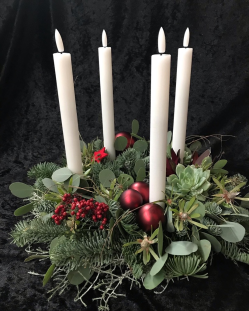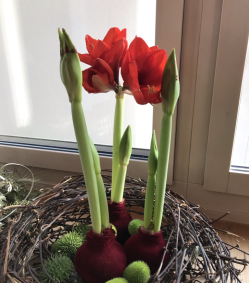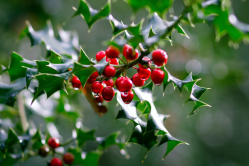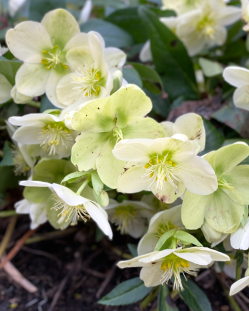Questions about popular Christmas plants: “Year after year”

Remove plant remains, drink something and wait and see
In most plant books and on the internet, you will read that Advent plants are toxic. Fortunately, Tox Info Suisse largely records no symptoms or in the worst-case scenario only mild gastrointestinal symptoms in connection with festive plants. The dose makes the poison.
Young children only nibble the plants, put the leaves and flowers in their mouth and will then stop. Adequate first aid would be taking plant remains out of their mouth and giving the child something to drink. The most common advice issued by Tox Info Suisse to parents is therefore to observe their child at home. If any symptoms do arise, they are usually mild gastrointestinal symptoms, which can generally be managed well at home. Measures to neutralise the toxin or hospital admission are hardly ever required.
96% without symptoms
Common and generally harmless holiday suspects:
The poinsettia (Euphorbia pulcherrima) is a very popular houseplant at Christmas with its red, star-shaped flowers. Yet many people don’t keep in mind that the plant is highly toxic due to its white milky sap. While the plant is not suitable for consumption, it is harmless in the amounts that children typically consume to taste.
Skin or eye contact with the milky sap results in mild irritation at most. There are known allergic reactions. Tasting the green leaves, the coloured bracts (the star-shaped leaves) or the plain blossoms can cause gastrointestinal symptoms.
Read more here: Pointsettia

Amaryllis (Hippeastrum vittatum) provides a great deal of joy at Christmastime or over New Year when the bulb – with good care – finally blossoms. And they are often gifted during the holidays as cut flowers.
All parts of the amaryllis are toxic. The bulb is the most toxic due to the high content of amaryllidaceae alkaloids. Generally, children only sample small parts of the decorative amaryllis (flowers, stem, leaves) and so this will only cause mild gastrointestinal symptoms, if any.
Read more here: Amaryllis

The bright red berries of holly (Ilex aquifolium) liven up Advent wreaths.
Although the red berries look tempting, they are toxic. Fortunately, usually only a few berries are consumed and therefore the five red berry rule (in German) applies to almost all little tots. Consume up to five red berries and you shouldn’t expect anything more than mild gastrointestinal symptoms. Barely any small child tries to eat the hard and prickly leaves voluntarily.
Sprigs of mistletoe (Viscum album) are hung up as lucky charms and decoration outside and above doors, staying fresh for a long time (“kiss me under the mistletoe”).
The round white “berries” of the mistletoe are sticky and have a slightly bitter taste. They are either only slightly or not at all toxic. The rest of the plant is toxic, with the toxins dependent upon the host plant. However, thanks to being fixed high up above the door, mistletoe sprigs are usually out of the danger zone of pets and young children.

The Christmas cactus (Schlumbergera truncata) owes it name and popularity to its flowering period in the winter months.
It is a harmless plant, although it may cause allergic reactions upon contact with the skin and eyes.
Festive suspects that require particular care:
On the internet you will find various instructions about how to break up Advent wreaths with sprigs of yew tree (Taxus baccata). The boughs can also make a nice decoration under Christmas trees. However, in households with pets and children, Tox Info Suisse advises picking less toxic fir sprigs.
Aside from the red berries, the plant is highly toxic to humans and animals. Luckily, children generally only try putting a few needles in their mouths, which can cause mild gastrointestinal symptoms. However, consuming large quantities of the needles can be life-threatening.
Read more here: Yew (only in German)

The Christmas rose (Helleborus niger, syn. Black hellebore) is a garden and outdoor pot plant. It flowers in the winter months and can provide decoration, for example, at the entrance to a house.
Poisoning and questions about the Christmas rose are rare. Compared with other plants, it is mainly animals that are affected, which is probably because the plants are predominantly located outside. All parts of the Christmas rose contain toxins. Those who have tasted the plant have described a feeling of burning and scratching in the mouth as well as increased saliva, potentially followed by gastrointestinal symptoms. Cardiac symptoms may occur in the case of larger quantities.
What should you do in the event of an accident with the plants described above?
After swallowing small parts/quantities of the plant:
- Do not induce vomiting.
- Remove any plant remains, wash out mouth.
- Drink 100-200 ml of clear, fat-free fluid,
e.g. water, cordial or tea - Only take activated charcoal following consultation with Tox Info Suisse or a doctor.
After swallowing yew needles:
- Contact Tox Info Suisse even if there are no symptoms or symptoms are mild.
- If symptoms are pronounced, call for an ambulance (emergency number 144).
In the event of eye and skin contact with plant sap:
- Wash your eyes or the affected skin parts thoroughly with water.
- If you wear contact lenses, remove these before washing your eyes!
Prevention
We advise caution in where you place pot plants and cut flowers, especially in households with children and pets as well as in care homes with dementia patients. Place the plants out of reach to minimise the risk of accidental consumption. This way joy at the sight of the plants is not overshadowed by anything.
Further information
¹ Phoradendron flavescens is native to America, Switzerland is home to Viscum album
December 2023





